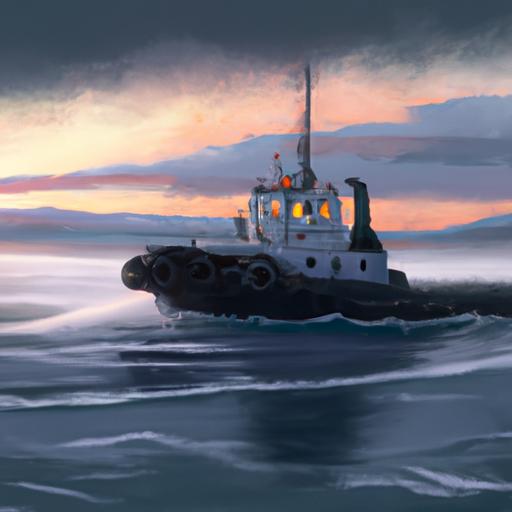Tugboats are an integral part of the transportation of goods and services around the world.
But have you ever wondered when tugboats were first invented? In this article, we will take a look into the history of tugboats, from the invention of the first steam tugboat to the uses of modern day tugboats, to understand how these powerful vessels have revolutionized the shipping industry.
We will also explore how tugboats have impacted the environment.
So, get ready to explore the captivating history of tugboats!
Table of Contents
Short Answer
Tugboats were invented in the early 19th century as a way to maneuver larger vessels through tight waterways.
The first tugboats were powered by steam and then later by diesel.
They were primarily used to tow larger ships in and out of harbors, but their uses have expanded over the years to include the towing of barges, fire fighting, ice breaking, and other marine services.
Overview of Tugboats
Tugboats are small but powerful vessels that are mainly used for towing, pushing, and guiding vessels in ports, harbors, and other confined waterways.
They are typically powered by steam, diesel, or electric engines, and are equipped with heavy-duty winches and other specialized equipment.
Tugboats are also used in various marine operations such as icebreaking, dredging, and transport, and they can be found all over the world.
The development of tugboats dates back to the early 19th century, when the first steam-powered tugboat was invented in 1833.
This revolutionary invention marked the start of the modern tugboat industry and revolutionized the shipping industry.
Prior to this, ships were towed by either sails or horses, making the towing process slow and inefficient.
With the invention of the steam-powered tugboat, the towing process was made much faster and more efficient, allowing ships to be towed more quickly and safely.
Since then, tugboats have been used in a variety of contexts, from towing barges and other vessels to helping ships enter and exit ports safely.
Modern tugboats are powered by diesel engines and are equipped with a variety of specialized machinery and equipment, such as winches and pumps.
They are designed to provide powerful towing and pushing capabilities, and they are often used in conjunction with other vessels to help move larger ships in and out of ports.
Overall, tugboats are an important part of the maritime industry and have been around for centuries.
They are powerful vessels that are used in a variety of contexts, from towing and pushing to helping ships safely enter and exit ports.
Modern tugboats are powered by diesel engines and are equipped with a variety of specialized machinery and equipment, making them an invaluable asset to the shipping industry.
The Invention of the First Steam Tugboat

The invention of the first steam-powered tugboat was a major milestone in the history of maritime transportation.
The first steam tugboat was invented in 1833 by British engineer Robert Fulton, who is also credited with inventing the steamboat.
Fulton’s steam tugboat was designed to tow larger vessels, making it easier for ships to navigate rivers and other waterways.
This invention revolutionized the shipping industry, as it allowed ships to be towed much more efficiently and quickly than ever before.
Fulton’s steam tugboat had a wooden hull and two paddlewheels, powered by a steam engine.
This was a major advancement in maritime technology, as it allowed ships to travel much faster than they had been able to before.
The invention of the steam tugboat also enabled ships to enter and exit ports much more quickly, as tugboats could tow them in and out of port efficiently.
Since its invention, the tugboat has been used in a variety of contexts, from towing barges and other vessels to providing assistance to ships entering or exiting ports.
In modern times, tugboats are powered by diesel engines and are often used in coastal and offshore marine operations, such as helping ships navigate tight channels and harbors.
They are also often used to tow barges and other vessels, or to perform emergency rescue operations.
Today, tugboats are an essential part of the maritime industry, and their invention has helped to revolutionize the way ships are towed and navigated around the world.
How the Tugboat Revolutionized the Shipping Industry
The invention of the tugboat revolutionized the shipping industry, completely changing the way vessels were able to move around the world.
Prior to the invention of the steam tugboat in 1833, ships had to rely on sails and sails alone to travel and traverse the seas.
This made the process of towing vessels or barges extremely difficult and time consuming.
The invention of the tugboat changed all of that.
By providing a powerful, self-propelled vessel that could be used to tow other ships, the tugboat allowed vessels to be towed more quickly and efficiently than ever before.
This dramatically increased the speed at which goods could be transported, and allowed for the more efficient transport of cargo.
The tugboat also made it much easier to maneuver ships in and out of ports.
By providing a powerful engine, tugboats were able to help ships enter ports safely and quickly, allowing them to dock without delay.
This made the transport of goods much more efficient, and allowed for a more reliable and consistent delivery of goods.
Overall, the introduction of the tugboat revolutionized the shipping industry, allowing ships to be towed more quickly and efficiently, and maneuvering them in and out of ports much more quickly and safely.
It was a game-changer for the industry, and allowed for a dramatic increase in the speed and efficiency of goods transport.
Different Types of Tugboats

Tugboats come in a variety of shapes and sizes and are built for specific purposes.
The most common type of tugboat is the conventional tug, which is designed for towing and pushing vessels.
This type of tugboat is powered by a single diesel engine and uses a bow-mounted propeller and stern-mounted rudder to maneuver.
Other types of tugboats include the tractor tug, which uses two engines and two propellers to maneuver more quickly and efficiently than a conventional tug; the Z-drive tug, which uses a propeller mounted at the stern and a rudder mounted at the bow for more precise maneuvering; and the Voith Schneider tug, which uses a rotating propeller for superior maneuvering and towing capabilities.
In addition, there are special purpose tugboats, such as firefighting tugs, ice-breaking tugs, and salvage tugs.
Each type of tugboat is designed to perform specific tasks, allowing them to be used in a wide variety of applications.
Uses of Tugboats
Tugboats have been used for a variety of purposes throughout their history.
In the modern day, they are used to assist ships in entering and exiting ports.
This is done by attaching a tow line to the stern of the vessel and using the tugboat to help guide it safely into position.
Tugboats are also used to move barges and other vessels around rivers and canals, as well as to assist in the construction of bridges and other marine structures.
They can also be used to move larger vessels in tight spaces or into dry dock for maintenance.
Their maneuverability and power make them invaluable in maritime operations.
Modern Day Tugboats

Today, modern tugboats are powerful vessels that provide a variety of services, from towing barges and other vessels to helping ships enter and exit ports safely.
These tugboats are powered by diesel engines and are equipped with advanced navigation and communication systems.
They come in a variety of sizes, from small harbor tugs to large ocean-going tugs.
Modern tugs are equipped with winches, tow lines, and anchors to provide effective towing and maneuvering capabilities.
Additionally, many of these vessels are equipped with firefighting and rescue equipment, making them essential for a variety of maritime operations.
Tugboats are also used for icebreaking, dredging, and other marine operations.
Thanks to their powerful engines, modern tugboats are able to move large vessels and barges quickly and efficiently.
This makes them invaluable in the shipping industry, as they are able to quickly move large vessels in and out of ports.
Tugboats and the Environment
Tugboats have been a major part of the shipping industry for centuries, and their impact on the environment cannot be overlooked.
Tugboats are an incredibly efficient way to transport vessels and cargo, as they are able to move quickly and navigate through shallow waters.
This makes them ideal for pulling and maneuvering large vessels in and out of ports.
However, tugboats also produce emissions in the form of exhaust gases, and this can have a negative effect on the environment.
Fortunately, modern tugboats have become much more environmentally friendly.
Today, most tugboats are powered by diesel engines, which produce fewer emissions than traditional fuel sources.
Additionally, tugboats are designed to minimize their carbon footprint, with hull designs that reduce drag and improve fuel efficiency.
This ensures that tugboats can continue to have a positive impact on the environment, while still providing the necessary towing and maneuvering services.
Tugboats also have a positive effect on the environment in other ways.
For example, tugboats are often used to clean up oil spills and other hazardous materials.
This helps to protect the environment from further damage.
Additionally, tugboats are used to tow barges carrying materials such as recyclables, which reduces the amount of waste that goes into landfills.
Overall, tugboats are an incredibly important part of the shipping industry, and they have a positive impact on the environment.
By using efficient engines and minimizing their carbon footprint, tugboats can continue to play an important role in keeping our oceans and waterways clean and safe.
Final Thoughts
Tugboats have been an integral part of our lives for centuries, and their history is full of fascinating stories of innovation and progress.
From the first steam tugboat in 1833 to modern-day diesel-powered tugboats, they have revolutionized the shipping industry and made it possible for us to travel the world.
As we learn more about the environmental impacts of tugboats, it’s important that we stay mindful of their role in protecting our environment and supporting the global economy.
By understanding the history of tugboats and their importance, we can continue to use them responsibly in the future.

